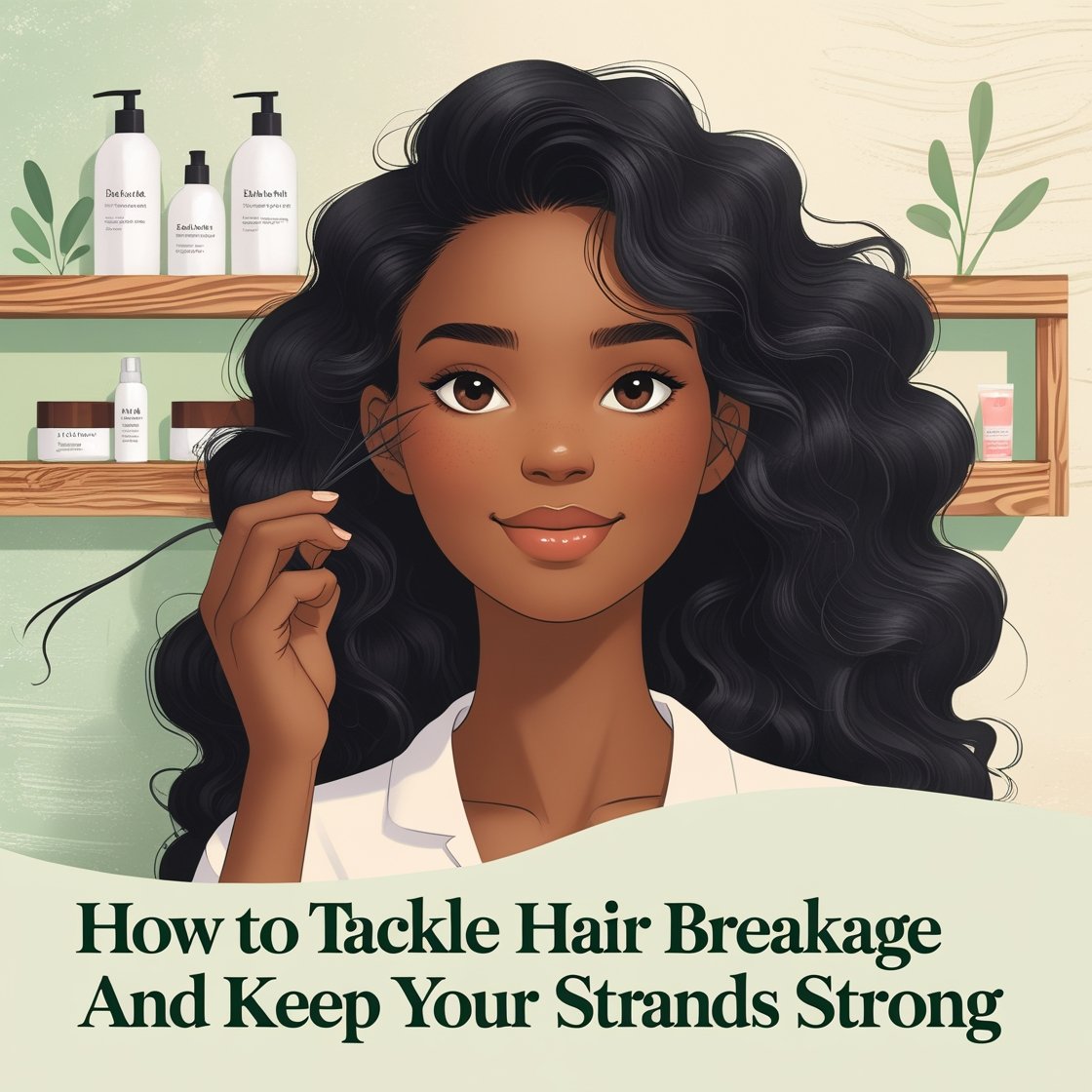How to Tackle Hair Breakage and Keep Your Strands Strong

Hair breakage is one of the most frustrating hair concerns that many people face. Whether it’s due to over-styling, environmental factors, or improper care, breakage can leave your hair looking weak, frizzy, and unhealthy. The good news is that hair breakage is preventable, and with the right approach, you can restore your strands to their healthiest state.
In this article, we’ll dive deep into the causes of hair breakage, offer expert tips to prevent it, and guide you through steps that can help keep your hair strong and resilient. If you’re ready to tackle breakage head-on and achieve healthier hair, keep reading!
Understanding Hair Breakage
Before you can prevent hair breakage, it’s important to understand what causes it. Hair breakage occurs when the hair shaft becomes weak and brittle, resulting in the hair snapping or splitting. Unlike hair shedding, which involves the hair falling out from the root, breakage occurs along the length of the strand, often at weak points.
There are several factors that can contribute to hair breakage, including:
-
Over-styling: Frequent use of heat styling tools like straighteners, curling irons, and blow dryers can weaken your hair, causing it to become brittle and break.
-
Chemical treatments: Harsh chemical processes like coloring, perming, and relaxing can compromise the integrity of your hair and lead to breakage.
-
Environmental damage: Exposure to the sun, wind, and pollutants can make your hair dry and prone to breakage.
-
Tight hairstyles: Constantly pulling your hair into tight ponytails or braids can cause strain on your hair, leading to breakage, especially around the hairline.
-
Improper hair care: Using the wrong products or not moisturizing your hair properly can make it dry, weak, and more likely to snap.
Signs of Hair Breakage
It’s important to identify hair breakage early so that you can take action before it worsens. Some signs that your hair may be breaking include:
-
Split ends: Split ends are one of the most noticeable signs of breakage. When your hair strands begin to fray and split at the ends, it’s a sign that they’re weak.
-
Short, broken pieces: If you notice shorter pieces of hair that don’t seem to grow, they may be breaking off.
-
Dryness and frizz: Breakage often goes hand in hand with dry, frizzy hair. If your hair feels rough to the touch and looks dull, it could be a sign of damage.
-
Thinning hair: Hair breakage can lead to thinning, as the hair becomes weaker and snaps along its length.
-
Brittle strands: If your hair is more fragile and snaps easily when combing or brushing, it’s likely experiencing breakage.
How to Tackle Hair Breakage
Now that we understand the causes and signs of hair breakage, let’s dive into practical solutions for tackling it and keeping your hair strong.
1. Avoid Excessive Heat Styling
One of the most common causes of hair breakage is excessive heat styling. Heat tools, such as flat irons, curling irons, and blow dryers, can damage the protective layer of your hair, causing it to become dry and brittle. While heat styling can create beautiful looks, it’s important to use these tools sparingly and with caution.
How to Fix It:
-
Limit Heat Styling: Try to limit your use of heat styling tools to once or twice a week. Opt for heatless styles like braids or buns to create waves or curls.
-
Use Heat Protectants: Always apply a heat protectant spray or serum to your hair before styling. These products form a barrier between the heat and your hair, reducing the risk of damage.
-
Lower Heat Settings: If you must use heat, lower the temperature on your styling tools. High heat can do more damage, so use the lowest setting that still gives you the desired results.
2. Trim Regularly to Prevent Split Ends
Split ends are one of the most noticeable signs of hair breakage, and they can worsen if not addressed. When hair is left untreated, the split ends can travel up the strand, causing more breakage and making your hair look thin and unhealthy.
How to Fix It:
-
Schedule Regular Trims: Trim your hair every 6-8 weeks to prevent split ends from spreading. Regular trims will keep your hair looking fresh and healthy.
-
Use Sharp Scissors: When trimming your hair, use sharp scissors specifically designed for haircuts. Dull scissors can cause uneven cuts and further damage.
3. Choose the Right Haircare Products
Using the wrong products for your hair type can contribute to breakage. Harsh ingredients, such as sulfates and parabens, can strip your hair of its natural moisture, making it more prone to damage. It’s essential to use products that nourish and strengthen your hair.
How to Fix It:
-
Use Moisturizing Shampoos and Conditioners: Look for sulfate-free, hydrating shampoos and conditioners that will help lock moisture into your hair. Ingredients like glycerin, argan oil, and shea butter can be great for keeping your strands hydrated.
-
Deep Condition Weekly: Use a deep conditioning mask once a week to restore moisture and repair damaged hair. Look for treatments with proteins like keratin and silk to strengthen the hair shaft.
-
Avoid Harsh Chemicals: Stay away from products that contain sulfates, parabens, and alcohol, as these ingredients can dry out your hair and contribute to breakage.
4. Protect Your Hair From the Elements
Environmental factors like sun exposure, wind, and pollution can damage your hair and make it more susceptible to breakage. UV rays can weaken the hair shaft, while wind can cause tangling and breakage.
How to Fix It:
-
Wear a Hat or Scarf: Protect your hair from the sun and wind by wearing a hat or scarf. This is especially important if you’ll be outside for an extended period.
-
Use UV Protection: Invest in hair products that offer UV protection, such as leave-in conditioners with SPF. These products create a barrier that helps shield your hair from sun damage.
5. Be Gentle When Brushing and Combing
Brushing or combing your hair too aggressively can cause unnecessary stress on your strands, leading to breakage. It’s important to be gentle and use the right tools when detangling your hair.
How to Fix It:
-
Use a Wide-Tooth Comb: When your hair is wet, use a wide-tooth comb to gently detangle your hair. Wet hair is more prone to breakage, so avoid using fine-tooth combs or brushes that can pull on your hair.
-
Start at the Ends: Always start combing or brushing from the ends of your hair and work your way up. This prevents pulling on the roots and causing unnecessary strain.
6. Eat a Hair-Healthy Diet
Your hair health starts from within. A poor diet can lead to hair thinning and breakage, so it’s important to nourish your body with the right nutrients to keep your hair strong.
How to Fix It:
-
Eat Protein-Rich Foods: Hair is made up of keratin, a type of protein. Ensure you’re consuming enough protein in your diet, such as lean meats, eggs, fish, and plant-based sources like beans and lentils.
-
Get Plenty of Vitamins and Minerals: Vitamins like biotin, vitamin E, and vitamin D, as well as minerals like zinc and iron, play an essential role in hair health. Consider adding foods like spinach, almonds, and sweet potatoes to your diet.
7. Avoid Tight Hairstyles
While hairstyles like ponytails, braids, and buns are convenient, wearing them too tightly can lead to hair breakage, particularly around the hairline and at the nape of the neck. Tight hairstyles can cause unnecessary tension on your hair and scalp, leading to stress on the hair follicles and breakage over time.
How to Fix It:
-
Opt for Looser Styles: Try wearing your hair in looser, more comfortable styles to avoid unnecessary tension. If you prefer ponytails or braids, avoid pulling your hair too tight, and make sure to alternate your hairstyle regularly.
-
Use Hair-Friendly Elastics: Avoid using rubber bands or elastics that can tug on your hair. Instead, use soft, fabric-covered elastics or hair ties designed to prevent breakage.
-
Give Your Hair a Break: Allow your hair to rest from tight hairstyles, especially if you’ve been wearing them frequently. Let your hair down or use protective styles like loose twists that won’t put too much strain on your hair.
8. Protect Your Hair at Night
While you sleep, your hair is vulnerable to breakage from friction caused by pillows and sheets. Constant rubbing against rough materials can weaken the hair shaft and cause frizz and split ends. However, there are simple solutions to protect your hair while you sleep.
How to Fix It:
-
Use a Silk or Satin Pillowcase: Swap your cotton pillowcase for a silk or satin one. These materials create less friction, helping to reduce hair breakage and frizz.
-
Protective Hairstyles: You can also braid or loosely tie your hair before bed to prevent tangling and friction. This will help preserve the integrity of your hair and prevent it from snapping while you sleep.
Conclusion
Dealing with hair breakage can be frustrating, but with the right strategies in place, you can significantly reduce damage and promote healthier, stronger strands. From limiting heat styling and choosing the right products to protecting your hair from environmental factors and tight hairstyles, there are many ways to give your hair the care it needs.
Remember, patience is key when it comes to reversing hair breakage. It takes time for your hair to recover and grow back healthy. By adopting these practices, combined with a nourishing diet and gentle care routine, you’ll be well on your way to enjoying strong, resilient hair.
With a little attention and the right habits, you can achieve the healthy, beautiful hair you’ve always wanted. So, start today and give your strands the TLC they deserve!







